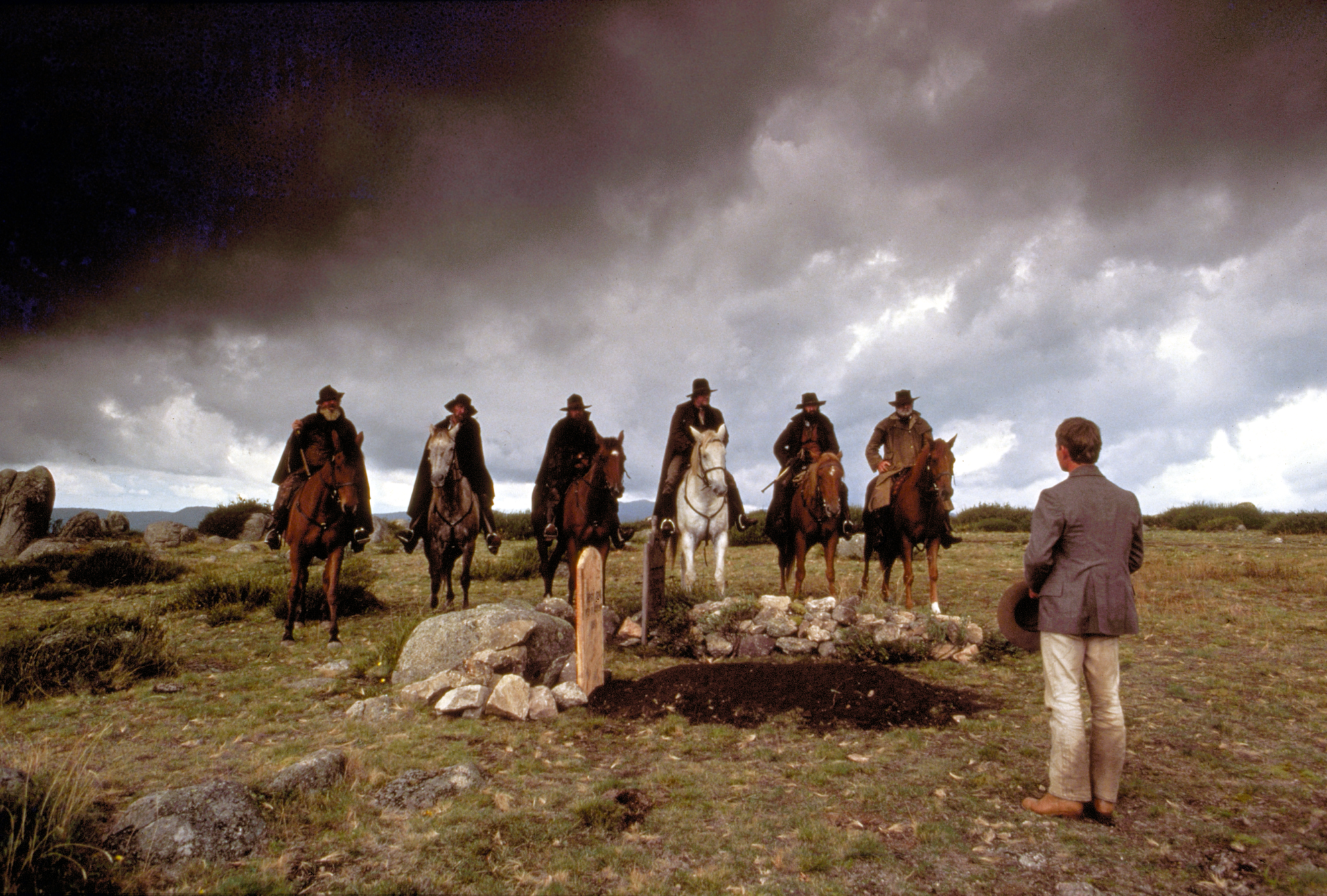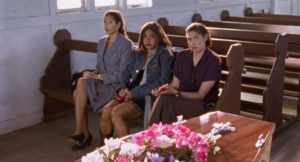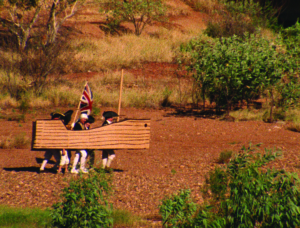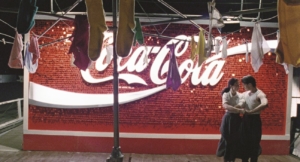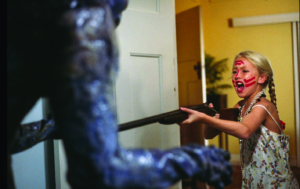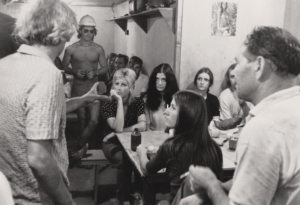George Miller’s The Man from Snowy River (1982) is, by many measures, one of the most successful Australian films of all time. Widely loved and hugely profitable, the film drew on the deftness of Australian television drama to help reorient Australian filmmaking towards a popular and international audience. Yet The Man from Snowy River also has a complicated and contested legacy: too gauche for cinephiles and too glossy a portrait of Australia for progressive audiences, it was critically flayed upon release and has received far less attention over time than its contemporaries Gallipoli (Peter Weir, 1981) and Breaker Morant (Bruce Beresford, 1980). It is a film that lives in the space of a certain kind of national iconography: as Tom O’Regan puts it, The Man from Snowy River is from the world of ‘the cigarette commercial, clothes fashions, real estate, tourism, soap opera (melodrama), bush dancing, John Ford and John Wayne’.[1]Tom O’Regan, ‘Ride the High Country: The Man from Snowy River & Australian Popular Culture’, Filmnews, September 1982, p. 8. Within this contradiction of popular appeal and critical discomfort lies the fascinating enigma of The Man from Snowy River.
The idea for the film came during a dinner party. Geoff Burrowes, the film’s producer and driving force, was challenged by the wife of a friend: ‘Why doesn’t someone in the film industry do something that is central to Australia’s heritage rather than always dealing on the edges of it?’ She suggested Paterson’s poem ‘The Man from Snowy River’, though Burrowes was initially hesitant: ‘It’s too well-known. It’s almost a cliche. Anyway, it’s too short; it only runs five or seven minutes. How can you make a film out of that?’ Somewhat perplexed by his own negative reaction, though, Burrowes eventually realised that, in fact, Paterson’s poem would make an excellent climax to a film. He contacted director George Miller (no relation to the Mad Max director of the same name) to begin work: ‘All we need is another 90 minutes!’[2]Geoff Burrowes, quoted in George Tosi, ‘Geoff Burrowes and George Miller: Two Men Behind Snowy River,’ Cinema Papers, issue 38, June 1982, p. 207.
That the task of adding a ninety-minute prologue to perhaps Australia’s most famous poem should fall to Burrowes and Miller was difficult enough. Yet it was even more ambitious, as neither of them had actually made a feature film before. They were colleagues from Australian television, which, at the time, was a very different industry from feature-film production. They had undertaken apprenticeships at Crawford Productions, Australia’s premier television studio; responsible for Seven’s Homicide as well as Nine’s Division 4, The Sullivans and The Flying Doctors, the production house’s ‘titanic achievement was to show commercial networks they needed Australian drama and how to make it’.[3]Jock Given, ‘Did the Networks Kill Homicide?’, Inside Story, 2 July 2014, <http://insidestory.org.au/did-the-networks-kill-homicide>, accessed 21 August 2017. These were Australian stories with Australian accents – from police and doctors to average middle-class families. Miller, who had directed episodes of Homicide, The Sullivans and Ten’s Matlock Police, epitomised the Crawford approach to talent when he arrived as a 21-year-old interested in photography. ‘They trained you to do everything, they’d throw you in at the deep end to see if you sank or swam,’ he told The Sydney Morning Herald in 2008. ‘I was one of the ones who swam’.[4]George Miller, quoted in Lucinda Schmidt, ‘Profile: George Miller’, The Sydney Morning Herald, 6 February 2008, <http://www.smh.com.au/news/money/profile-george-miller/2008/02/04/1202090322001.html>, accessed 21 August 2017.
Australian television companies like Crawford were hothouses of production talent. Yet that talent rarely crossed over into feature-film production and, up until the 1980s, the two industries were widely regarded as separate beasts. Under Gough Whitlam’s government, they were, in fact, very much divided, with television policy falling to the then–minister for the media, Douglas McClelland, and film being overseen instead by the office for the prime minister. While the film industry was considered by bureaucrats to be capable of making art, television, according to O’Regan,
was cast in the devil’s clothes. It was crude, unsophisticated, uncreative. It was not, in short, what the new Australia – an Australia equipped with cultural capacities by the unprecedented expansion in arts expenditure in the Whitlam years – needed.[5]O’Regan, op. cit., p. 8.
However, as the 1970s became the 1980s, the film industry gained greater support and, crucially, tax concessions for production, which included television miniseries. This allowed for more lateral movement between the industries and for a shift in aesthetics as populist television workers began to contribute to feature films. This ‘10BA’ era (citing the relevant section in the Income Tax Assessment Act 1936) saw a dramatic growth in films produced, and also in popular international hits – not just The Man from Snowy River, but also The Year of Living Dangerously (Peter Weir, 1982), Mad Max 2: The Road Warrior (George Miller, 1981) and Crocodile Dundee (Peter Faiman, 1986) – before the 10BA subsidy was wound back from 1988.[6]Alex Burns & Ben Eltham, ‘Boom and Bust in Australian Screen Policy: 10BA, the Film Finance Corporation and Hollywood‘s “Race to the Bottom”’, Media International Australia, Incorporating Culture & Policy, no. 136, 2010, pp. 105–6.
The straightforward, non-ironic approach of television was well suited to this moment in Australian film history. Local audiences had recently flocked to the cinemas to enjoy the sincere American genre homage of Star Wars (George Lucas, 1977)and Raiders of the Lost Ark (Steven Spielberg, 1981). And, as O’Regan points out, a film like The Man from Snowy River was successful in part because it ‘is getting to the cinema the same audience that makes Cop Shop, A Country Practice, The Sullivans and A Town Like Alice rating successes on Australian television’, but also because it gave audiences earnest entertainment in the same way that Star Wars had.[7]O’Regan, op. cit., p. 8. There was a kinship between such straight-faced international blockbusters and Australia’s locally produced, perhaps naive, television dramas, particularly in terms of their uncomplicated audience appeal.
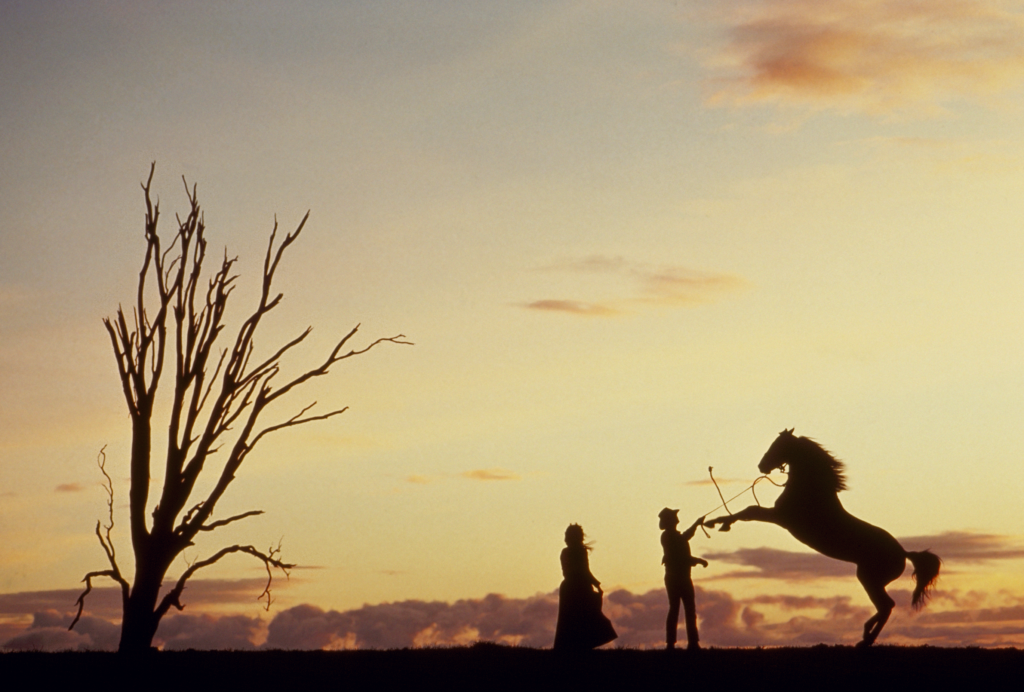
Adapting AB ‘Banjo’ Paterson
In many respects, The Man from Snowy River has a lot in common with the ‘high-concept’ American blockbusters of the 1970s and 1980s. Its marketing hook can be boiled down to two salient points: the film is based on an already-popular work (much like William Friedkin’s 1973 The Exorcist and Spielberg’s 1975 Jaws) and it builds to a spectacular climax (in this case, the horse chase that is recounted in Paterson’s poem). Little contextual information is given in the source text, which begins with the search for an escaped colt and ends with its retrieval from a wild herd of bush horses. However, as adapted by Burrowes and Miller, the poem becomes a mythic coming-of-age story for the titular man. As Miller argued,
He is referred to as a lad in the early part of the poem, and at the end as ‘the man’. What does that tell you? That the ride is his passage into manhood, the definitive act of growing up.[8]George Miller, quoted in Tosi, op. cit., p. 208.
Taking the man from the poem and calling him ‘Jim Craig’, Miller and Burrowes took the other two characters mentioned in the poem – Harrison, the ‘old man with his hair as white as snow’, and Clancy of the Overflow – and sketched out a broad plot focusing on family, the land and myth-making.
Jim (Tom Burlinson, another television talent) and his father, Henry (Terence Donovan), are making a hard but decent living in the Australian highlands when, one day, the appearance of a pack of wild horses leads to Henry’s death and Jim’s being orphaned. After the funeral, Jim is confronted by a group of other mountain men, who tell him he must earn the right to work on his father’s station; he then journeys to the plains and encounters the wealthy Harrison (Kirk Douglas) and his large horse-rearing business. There, Jim also meets Harrison’s independent and sharp daughter, Jessica (Sigrid Thornton), whom he quickly falls in love with; the semi-mythic Clancy of the Overflow (Jack Thompson), a gifted horseman and a friend of Jim’s father; and even Banjo Paterson himself (David Bradshaw), who plays the role of an onlooker, suggesting fidelity to the ‘actual’ events depicted in the original poem (which are largely agreed to have been Paterson’s invention).
Through Jim’s presence, the family’s history begins to unravel, especially when it is revealed that Spur (also Kirk Douglas), Jim’s old family friend, is Harrison’s estranged brother, and that they were both in love with Jessica’s mother, Matilda. Jessica flees to the mountains, where she falls off a cliff, only to be rescued by Jim. Out of anger at Jim’s success, some of Harrison’s workers (one, Curly, is played by Chris Haywood in an early role) release the latter’s prize colt – a horse worth £1000 – which joins the wild horses that killed Jim’s father. To prove himself and complete his coming-of-age narrative, Jim must find and recapture the colt.
Although the film’s plot is complicated along the lines of a family-relations soap-opera puzzle, its characters are plain and straightforward. Jim, in particular, is the kind of uncomplicated hero that is standard in myth and fairytale, but unusual in Australian cinema of the time (and indeed since). As Jack Clancy, in his 1983 defence of The Man from Snowy River, noted, ‘Only with The Man from Snowy River does one find a hero who is all virtue, who dares, overcomes and triumphs. Australian cinema has been a long time getting round to it.’[9]Jack Clancy, ‘Second Glance: The Man from Snowy River, Parents and Orphans’, Cinema Papers, issue 42, March 1983, p. 52. Other successful Australian films at the time may have had strong patriarchal leads, such as the Mel Gibson figures in Mad Max (Miller, 1979), Gallipoli and The Year of Living Dangerously, but all of these were also wounded or defeated visions of masculinity. In contrast, The Man from Snowy River offered a hero who was uncompromising and uncompromised.
When it came to casting, Burrowes and Miller again returned to their television roots. Thornton was immediately cast in the role of Jessica, as Miller had been working with her since she was a teenager; she was also known to the public for her performance as Kate Kelly (Ned’s sister) in The Last Outlaw, a 1980 miniseries that Miller had worked on as a director. After 2000 candidates and forty-five auditions, Burlinson, who was also already popular due to his role on Ten’s soap opera The Restless Years, was cast as Jim, largely based on his chemistry with Thornton: ‘It required no rational appreciation of the screen test, no discussion or intellectual strain,’ said Burrowes.[10]Burrowes, quoted in Tosi, op. cit., p. 209.
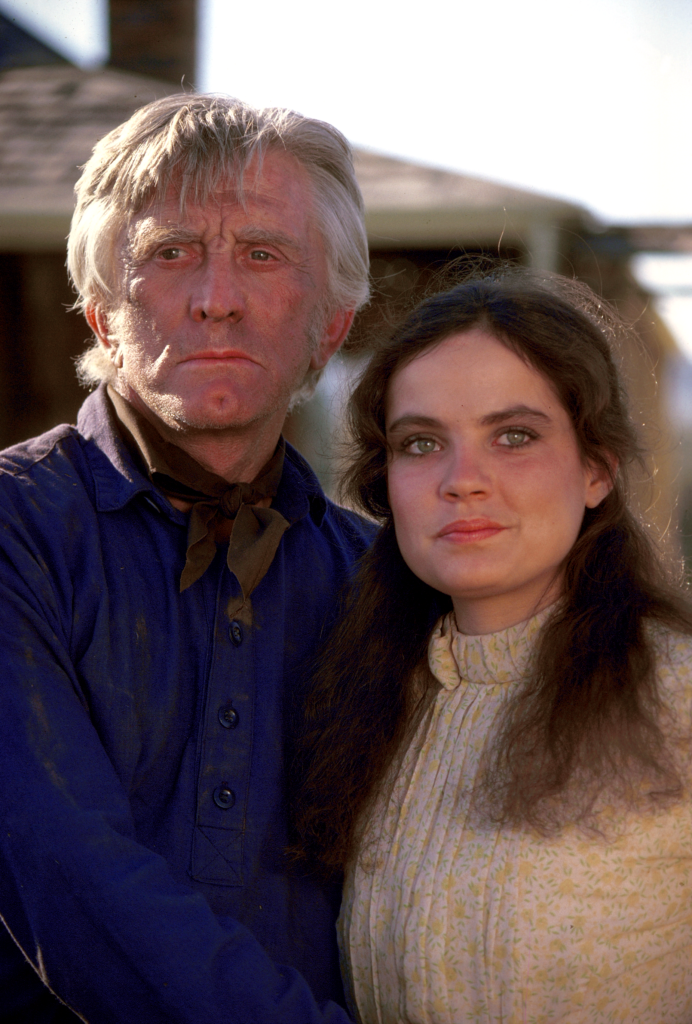
The selection of Douglas as both Spur and Harrison required more work. Originally, the two characters were unrelated, and to be played by two different actors, but casting difficulties led them to look overseas for a star. According to Burrowes:
there are few actors in the world with that amount of power who can play a 60-year-old. You can think of George C. Scott, Sean Connery, Burt Lancaster and Kirk Douglas, then you start to hiccup, close your eyes and cough.[11]ibid., p. 210.
Several of these bigger international names were approached, and Douglas was eventually signed for a rumoured A$1 million. Though Miller described Douglas as ‘not an easy man to work with’,[12]ibid. his inclusion in the film undoubtedly helped The Man from Snowy River cut through in the American market, much to some Australian critics’ chagrin. Indeed, Actors Equity, who had to give their permission for a foreigner like Douglas to be cast, seemed apprehensive – with a spokesman for the union, Uri Wendt, commenting that Douglas was ‘a funny sort of casting for the man from Snowy River’. Meanwhile, others, on hearing the news, suggested that Thompson – by then a marquee Australian actor and who had already been cast as Clancy – would make just as good a Man from Snowy River as Douglas.[13]Dougal McDonald, ‘Kirk Douglas Is Snowy Man’, The Canberra Times, 3 March 1981, p. 13.
Yet before any of these major casting moves, and despite having a story and a script, a year-and-a-half into the project, Burrowes and Miller were still struggling to find funding. It was their biggest hurdle, as relative outsiders to the film industry. They were aware that they lacked ‘credentials’, with Burrowes noting the disparity between their television experience and what would serve as valued experience to the film industry. Executives told them to make it for television or, in one case, as a musical.[14]Burrowes, quoted in Tosi, op. cit., p. 210. Eventually, with the help of Simon Wincer (another notable director and producer emerging out of the Crawford stable, who would go on to make Phar Lap in 1983), Michael Edgley was recruited as co–executive producer. This was another unusual decision: Edgley ran the company Edgley International, a major player in the theatre and music-promotions world, but an outsider to cinema. ‘Michael wanted to get into film and television in a big way,’ recalled Burrowes. ‘But none had excited them and they were keen to find a good project […] we talked, and in half-an-hour we had a deal.’ The honed marketing machinery of a promotions company like Edgley was a huge advantage to The Man from Snowy River’s production. Such infrastructure was easily repurposed for cinema, which, in Australia, was more used to ad hoc publicity. ‘You make a [A]$3 million film and you spend [A]$10,000 on publicity! What kind of mistake is that?’ said Burrowes. ‘Edgleys [sic] worked full-time dreaming up ways of publicizing and promoting this film.’[15]ibid.
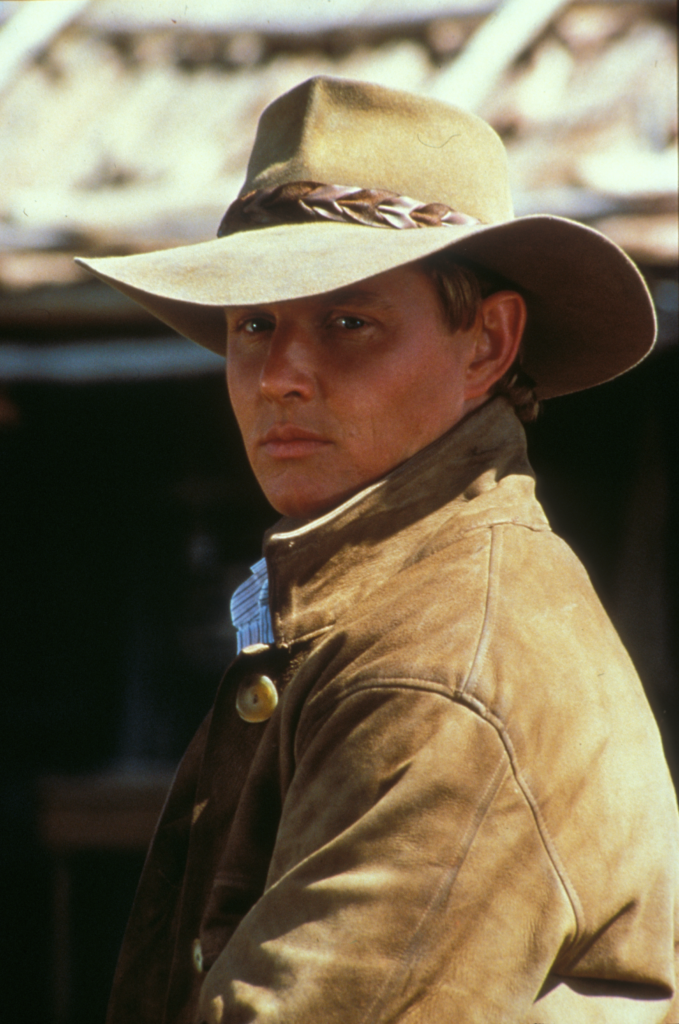
The reception
Financially, the strategy was an unmitigated success. The Man from Snowy River quickly became the highest-grossing Australian film at the time, with A$17,228,160 in takings, easily surpassing contemporaneous hits Gallipoli (A$11,740,000), Mad Max 2 (A$10,847,491) and Breaker Morant (A$4,735,000).[16]Screen Australia, ‘Top 100 Australian Feature Films of All Time’, 16 May 2017, <https://www.screenaustralia.gov.au/fact-finders/cinema/australian-films/top-films-at-the-box-office>, accessed 21 August 2017. It also outdid even the seemingly un-outdo-able Star Wars – a fact happily pointed out by the ever-assertive Burrowes[17]Bob Thomas, ‘Man from Snowy River – “A Remarkable Movie”’, The Canberra Times, 26 January 1983, p. 20. – and would’ve been the most successful film ever released in Australia if not for the release of Spielberg’s E.T. the Extra-Terrestrial that same year. When, in March 1985, Burrowes and Miller’s film was broadcast on television, their home turf, even more evidence of their strategy’s success was accrued. On Channel Nine, The Man from Snowy River was prodigiously successful, and even today retains the second-highest ratings of an Australian film on broadcast television ever in both Sydney and Melbourne.[18]Screen Australia, ‘All-time Top-rating Australian Feature Films on Television, 1980–2009’, <https://www.screenaustralia.gov.au/fact-finders/television/australian-content/in-the-archive/top-movies-of-all-time>, accessed 21 August 2017. Audiences simply could not get enough of it.
The international aim of The Man from Snowy River was also on-target, taking US$20,659,423 in the United States. Again, this was something that Burrowes was keen to point out: when critic Jack Clancy claimed that The Man from Snowy River had underperformed internationally, producer Burrowes took out a signed, full-page advert in Cinema Papers to respond that the film has ‘got $18.5 million to say Cinema Papers is wrong’:
It has played in as many as 700 theatres at any one time. As well, it was nominated by the Hollywood Foreign Press Association for a Golden Globe as best foreign film. And it won for director George Miller the most popular film award at the Montreal World Film Festival.
With American free and pay TV to come, with the rest of the world about to start, I will go on record as saying that Snowy River will gross at least $35 million overseas.[19]Geoff Burrowes, ‘“Snowy River’s” Got $18.5 Million to Say Cinema Papers Is Wrong’, advertisement, Cinema Papers, issue 43, May–June 1983, p. 156.
Indeed, Burrowes and Miller were right to look to the international market for their film. Though relatively unusual for Australian productions at the time, the internationalisation of local productions has since proven to be a hallmark of success for Australian cinema. Screen Australia’s analysis of contemporary Australian film argues that ‘a strong international performance is much more important to the bottom line than a strong local performance’.[20]Sandy George & Bernadette Rheinberger, ‘94 Films: A Commercial Analysis’, Screen Australia website, 11 April 2017, <https://www.screenaustralia.gov.au/sa/screen-news/2017/02-28-94-films-a-commercial-analysis/part-3-best-financial-performers>, accessed 21 August 2017.
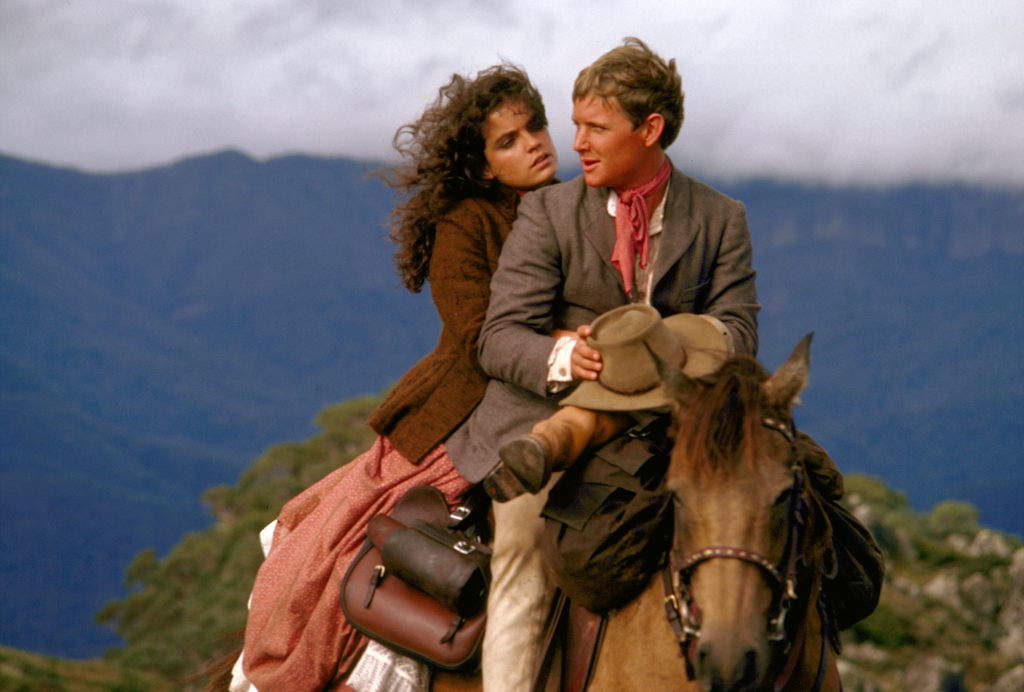
The wall-to-wall promotion of The Man from Snowy River, however, also primed a certain kind of critical response to the film. Filmnews began its review by claiming that the film had been ‘unleashed onto the market with a fanfare of media claptrap that must equal if not surpass a royal visit’, and ended by describing it as ‘a joke’.[21]Denise Hare, ‘Man from Snowy River’, Filmnews, April 1982, p. 13. This more or less reflected the general Australian critical appraisal of The Man from Snowy River. In contrast to audiences’ embracing of the film, critics hated it. John Hindle of The National Times called it a ‘tragedy, a costly awful mess’; Neil Jillett, in The Age, conceded, ‘The horses are good, the scenery is great, and that is all that can be said about The Man from Snowy River.’[22]Both cited in Arnold Zable, ‘The Man from Snowy River’, Cinema Papers, issue 38, June 1982, pp. 261. Arnold Zable, writing in Cinema Papers, tried deliberately to salvage the film from its critics, yet even then wound up arguing, ‘The scripting is riddled with cliches and soap opera banalities’ and rebuked the film for its lack of visual depth when compared to Akira Kurosawa’s Dersu Uzala (1975).[23]ibid., pp. 261–2.
Generally, there seems to be an ongoing reluctance to fully embrace The Man from Snowy River among cinephiles and scholars. In the context of Australia’s cinema classics, the film has received relatively little attention; even in contrast to the other Australian-made box-office hits of the 1980s and the 10BA era, the film remains relatively unattended to.
Colts, clouds and cinematography
Yet the film is not quite the dire, amateurish experience that its critics have made it out to be. I take Burrowes at his word when he claims that the populist, entertainment-first approach of the film was intentional and deliberately considered: ‘We’re not talking about entertainment in lieu of art, we’re not talking about entertainment in lieu of craft,’ he said in 1982. ‘It is art and craft disciplined, orientated, targeted and controlled.’[24]Burrowes, quoted in Tosi, op. cit., p. 283. It then seems incumbent on any analysis of the film to engage with it not just as a work of commercial culture, but also on its own artistic terms, too.
Indeed, there are many aesthetic elements of The Man from Snowy River that bear closer notice. Visually, the film attempts a tight balance between a hyper-specific, unstaged authenticity and an occasionally escapist, even fantastical anti-realism. In some ways, these contrasting approaches are encapsulated in The Man from Snowy River’s two elements that even its critics usually agreed were its strengths: landscape and horses. The landscape of the film is clearly shot with a tourist’s eye in mind, featuring numerous sweeping shots of the Australian mountains and plains. Although The Man from Snowy River is set at Mount Kosciuszko in New South Wales, the filmmakers opted instead to shoot at Mansfield in northern Victoria. The film was developed with the Mansfield area in mind because, for Miller, ‘Kosciuszko doesn’t look like a mountain – just a feature on a high plateau. When I went to look at it, I drove right past.’[25]Miller, quoted in Tosi, ibid., p. 209. This eventually paid dividends for the Mansfield region, which today still uses the film as the basis for a modest tourism industry.
The Man from Snowy River makes extensive use of classical framing for its landscape, with many long-lensed establishing and action shots that take careful note of the beautiful setting. Cinematographer Keith Wagstaff deliberately frames many of his shots to best utilise depth in the image, often moving the camera to highlight the sheer expanses of space available on location. Cameras move on cranes, sweeping from establishing shots to mid shots and back again, carefully amplifying the viewer’s sense of space and the possibilities of the Australian wilderness in the process. A number of sequences see the camera tracking sideways through bush scrub and forest, using the density of trees in the foreground and background to create a parallax effect.
Equally effective is The Man from Snowy River’s use of in-camera stunts and special effects to heighten the period realism and spectacle. In just the second major scene of the film, we see Jim and his father actually cut down a large Australian tree without any clear editing or cutaways – as far as the audience can see, the tree is felled before our own eyes. This kind of bush work is shot to emphasise the browns, greens and yellows of the scene, perhaps invoking well-known imagery of Australian pioneer life, such as Frederick McCubbin’s 1904 painting The Pioneer. The film’s overall set dressing and costume design was also meticulously researched: Miller goes so far as to claim that the look of the film was ‘the culmination of 20 years’ research on the part of the art director, Les Binns’.[26]ibid., p. 283.
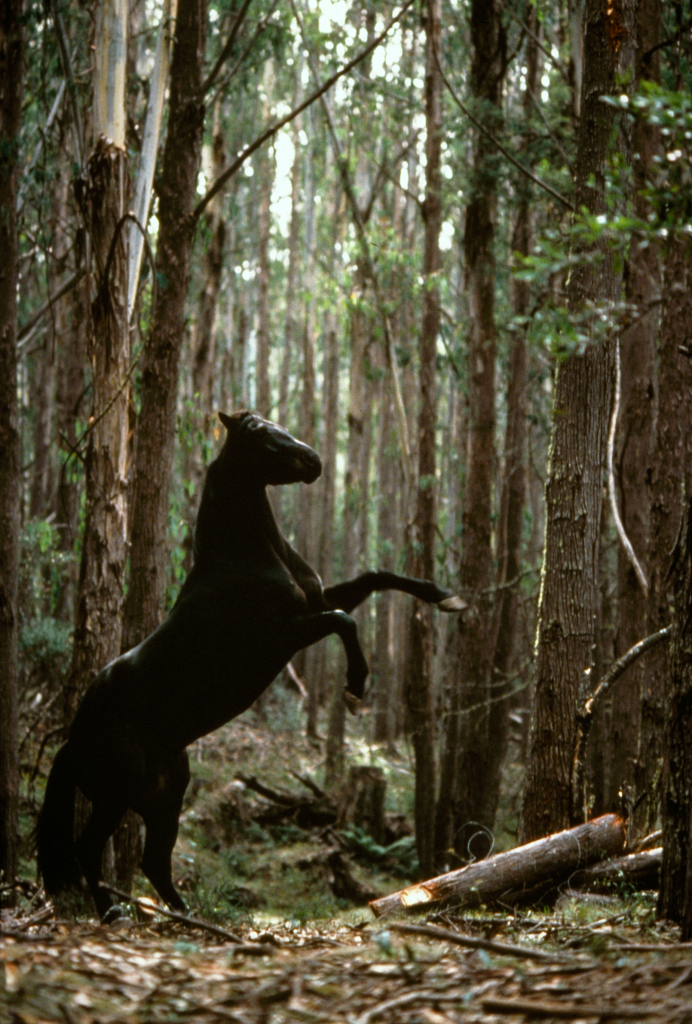
Equally, we can look towards The Man from Snowy River’s spectacular use of horses as another visual regime of authenticity and period realism. The film puts the spectacle of horses, which had perhaps gone out of fashion with the decline of the cinematic western, to superb use. Scenes of massed colts and brumbies at the film’s climax are particularly striking, as the terror of so many live animals on set hits the viewer. Burlinson’s own horseriding skills are particularly remarkable: not having ridden before he began working on the film, he trained for five weeks in order to get to the point where he was able to perform all of his own stunts, including the film’s iconic cliff-side descent at full canter.[27]Bunty Turner, ‘A Bush Legend Comes to Life’, The Australian Women’s Weekly, 6 May 1981, p. 14. The sense that each horse-centric sequence is, to some degree, impossible to fake is one of the film’s strongest appeals to spectacle.
However, Miller also uses horses as loci for several gestures towards anti-realism, an approach otherwise unusual for the film, its genre and the various other Australian works it often finds itself compared to, which usually prefer to maintain the diegesis throughout as much as possible. In contrast, The Man from Snowy River makes occasional but striking use of fantastical, dreamlike sequences to perhaps convey the mythologised nature of its subject matter. The film begins with striking, almost caricature-like images of horses running in moonlight. No single horse is discernible; instead, the image is one of assorted legs and torsos, shot in the abstract. This might appear to be simply a once-off prelude of things to come, or perhaps a vision of the horse’s centrality to the film, if not of the way The Man from Snowy River returns to this image time and time again as its defining iconography. It is almost used as montage or a cross-dissolve between other, unrelated sequences to remind us that, yes, these horses are present within the film’s plot even when not physically present – but also simply to produce an aesthetic effect of a world encompassed by these tempestuous forces.
Such gestures towards visual fantasy reach their zenith in two particular sequences. First, when Jim is injured by the wild mob of horses, we see him gazing up to their leader – the black colt, who stands above him. The colt is then presented in an array of unsettling still images that focus on the horse’s face and wild eyes as it attacks Jim deliberately. It is as though the audience has been brutalised as much as Jim, and as though this were the film’s own doing as much as the horse’s through this violent rupture with the diegesis. Secondly, once Jim rescues Jessica from the mountainous storm, we see a startlingly fantastical shot of the pair riding literally on clouds. Though most of this shot of Jim, Jessica and the horse has been unaltered, a layer of clouds has been superimposed at the horse’s feet. The overall effect is something like a cartoon, with a prancing horse carrying two satisfied lovers along a dreamlike bed of atmosphere. This, the most startlingly surreal image in a film otherwise dominated by appeals to period authenticity, reveals The Man from Snowy River’s phantasmagoric treatment of its horses, and its modulated visual regimes.
The theme from Snowy River
The story told by The Man from Snowy River is also a musical one. Bruce Rowland’s score is still widely beloved and recognisable, and is perhaps one of the few instances in Australian film history wherein orchestral fanfare of the type often found in Hollywood cinema was required and delivered. The score was recorded by a sixty-piece orchestra, and was the only element of the film that won an AFI Award in 1982, for Best Original Music Score. The music is infectiously noble and sincere, running its French horn and trumpet melodies over cantering strings and percussion. The sense of Australiana and national pride in the film is only ever amplified by the passionate score, which directly invokes the melody of ‘Waltzing Matilda’ (whose lyrics are, of course, taken from the Paterson poem of the same name) at the film’s conclusion. Miller, for his part, claims he ‘nearly wept’ when he heard it performed.[28]Miller, quoted in Tosi, op. cit., p. 211.
Yet The Man from Snowy River has a musical sensibility to it beyond the score as well. This is made clear from the very beginning: when Jim’s and Henry’s horses are disturbed in the first scene of the film, the latter jokes that it must have been due to Jim’s playing of a rickety old organ in their hut. ‘Must be your music,’ he says. ‘Alright, I’ll sing to it,’ Jim replies as he gets up to calm the horses.
Music as a broader communicative device resurfaces later in the film. In an early scene, Jessica struggles to play the piano well, with her instructing aunt complaining that the young woman does not know how to play like a lady. After Jim brings her a cup of tea, and has the chance to compliment her by calling her ‘pretty’, she returns to the piano and performs sensually. The inference is clear: music is used to illustrate how Jim’s very presence in Jessica’s life allows her to more comfortably inhabit the traditional gender roles carved out for her. And it resurfaces once more: after a montage of Jessica and Jim at the station alone, then falling in love through Jim’s breaking of the prize colt, we see Jessica sit down once again at her piano. Although Jim is outside the building in his own quarters, the montage implies that there is a shared consciousness between the two, despite their physical distance. This is reinforced by Jessica, who plays a romantic and deeply anachronistic piece of music on the piano – which the viewer eventually recognises as Rowland’s ‘Jessica’s Theme’ – that underscores the love scenes between her and Jim. Here, the non-diegetic score invades the diegesis of the film to reinforce the fantastical romance at the heart of the narrative: these two are connected not just by myth and fate, but by music, too.
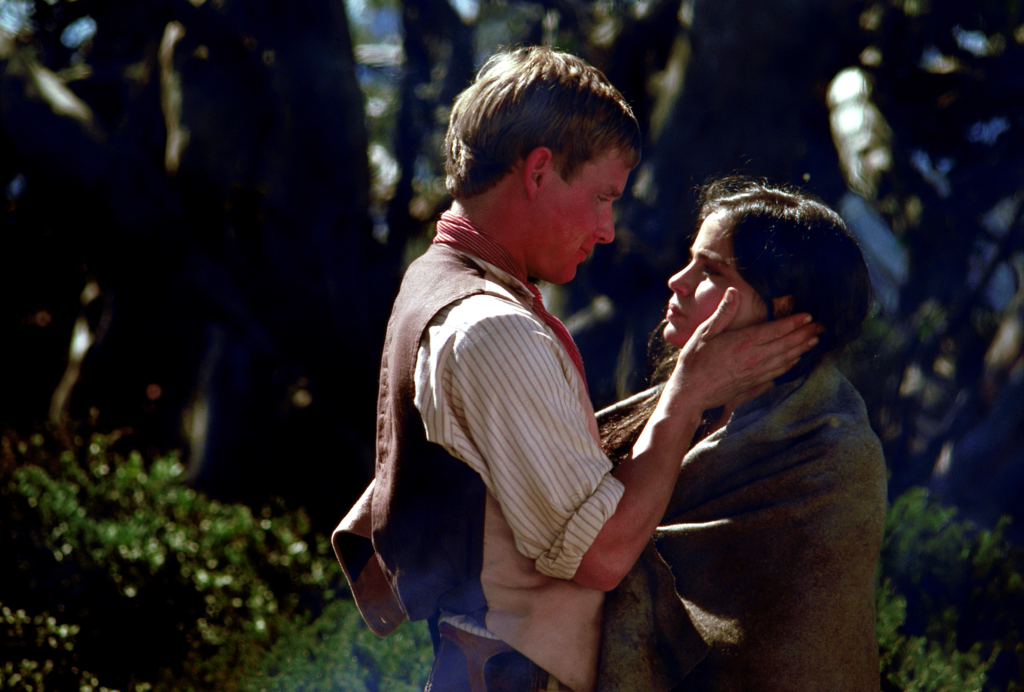
Myth-making and terra nullius
Of course, the legend that The Man from Snowy River tells is one of terra nullius, the legal fantasy that imagined that Australia was empty before Europeans arrived. To say that there is no Aboriginal presence in The Man from Snowy River is to understate things: not even the spectre of an Indigenous absence is invoked as the plot actually plays out a story of dispossession of land. Jim’s entire character arc is linked to the land and his ownership of it: after he is orphaned, local mountain men visit him and inform him that he has no moral claim over his family’s land until he has ‘earned the right’ to work it. It is not until he can become the titular ‘man’ that he can return to stake a claim to the mountain. Thus, he is rendered placeless and, although he feels at home in the mountains, he must journey to the plains and to the unkind and plutocratic Harrison to find work.
It is only the absence of any kind of Indigenous culture in the film that allows this plot to make any sense at all. The Man from Snowy River is entirely white and almost entirely Anglo-Saxon. The lone accented ‘European’ stockman – used as a tracker early in the film – is insinuated to have killed a man, something that is eventually sanctioned after he uses his threatening presence to help Jim. The heroes of the film simply exist naturally in this space, which is a long way from the threatening bush of other Australian films that deal with landscape, such as Picnic at Hanging Rock (Peter Weir, 1975) and Wake in Fright (Ted Kotcheff, 1971). As O’Regan points out,
White Australians in The Man are not ‘Europeans’. They are not ‘intruders in the Bush’ […] They are not maintaining and retaining in a ridiculous fashion their Europeanism in a hostile, alien environment. They are quite simply there and they manifestly belong there.[29]O’Regan, op. cit., p. 9.
The landscape is, accordingly, not alien or threatening. It is difficult, yes – ‘It’s a hard country, makes for hard men,’ says Spur – but it is controllable, manageable and even a home to these people. When Jessica gets lost and almost dies in the mountains, far from suffering from this traumatic experience, she actually seems to appreciate the land more. ‘Changes so suddenly, doesn’t it? One minute it’s like paradise, the next it’s trying to kill you,’ she says, awestruck.
Equally linked to this uncomfortable reframing of Australian history are the film’s iconic horses, and The Man from Snowy River often blurs the line between the horses and the land. The images of night-riding horses that serve as interstitial motifs for the film return time and time again, suggesting that the horses are a constant presence that, even if we haven’t seen them for a while, continue to act wildly and of their own volition. They are a continual threat, as though they exist externally to the storyline itself and are somehow intrinsically linked to the land. The fact that the film features a post-credit sequence with this imagery – despite the wild horses having been captured and tamed – suggests that, even though they’ve been captured, their free spirit somehow carries on in the film’s very substance. ‘Gotta treat the mountains like a high-spirited horse,’ Jim says after rescuing Jessica from the storm. ‘Never take her for granted.’ Jessica replies, ‘Same with people.’
Indeed, given that the plot of the film revolves largely around uncovering a traumatic family past, it may have seemed doubly important to allow audiences to forget Australia’s actual history. Much of the mystery at the heart of The Man from Snowy River relies on characters obscuring history, or only telling half-tales: Jessica does not know she has an uncle, or that that uncle is Spur; Harrison does not know whether he or Spur is Jessica’s real father; Jim does not know that the black stallion that leads the mob of horses that killed his father was, in fact, given to Jessica’s mother by Spur, which prompted Harrison to shoot his brother, which resulted in the loss of Spur’s leg. On and on the secrets go, all waiting to be uncovered by the characters and the audience. It is these elements that were criticised by contemporaneous critics as being soap-opera-like; perhaps, though, the aesthetics of such an emotional, puzzle-driven plot are less the point here than the way they serve to replace the actual history of Australia and its First Nations inhabitants. The land of The Man from Snowy River has no history to uncover except that which the white settlers brought with them. That this history is a traumatic one of loss and memory only serves to reinforce the complete absence of Aboriginality in the film.
The narrative’s denouement plays out when Jim literally lays claim not just to the land but to property and people in much the same manner. Having subdued and captured the wild mob of horses for Harrison, Jim rejects Harrison’s offer of the £100 reward. ‘There are a dozen good brood mares in that mob. I’ll be back for them.’ Turning to Jessica, who grins, he adds, ‘And for whatever else is mine, too.’ Putting aside the questions of terra nullius, this line ploughs right through any claim The Man from Snowy River has to progressively including a kind of feminism (a word that the film, debatably anachronistically, uses earlier to describe Jessica and her aunt’s assertion of their own value). As Rose Lucas argues,
In winning this ‘trophy’, Jim is sealed in joint transition to manhood and to hero-status, while the woman is revealed to be the conventional object who is passed, or taken, from father to son, thereby marking the transition, and indeed the reaffirmation of, patriarchal authority.[30]Rose Lucas, ‘Dragging It Out: Tales of Masculinity in Australian Cinema, from Crocodile Dundee to Priscilla, Queen of the Desert’, Journal of Australian Studies, vol. 22, no. 56, 1998, p. 140.
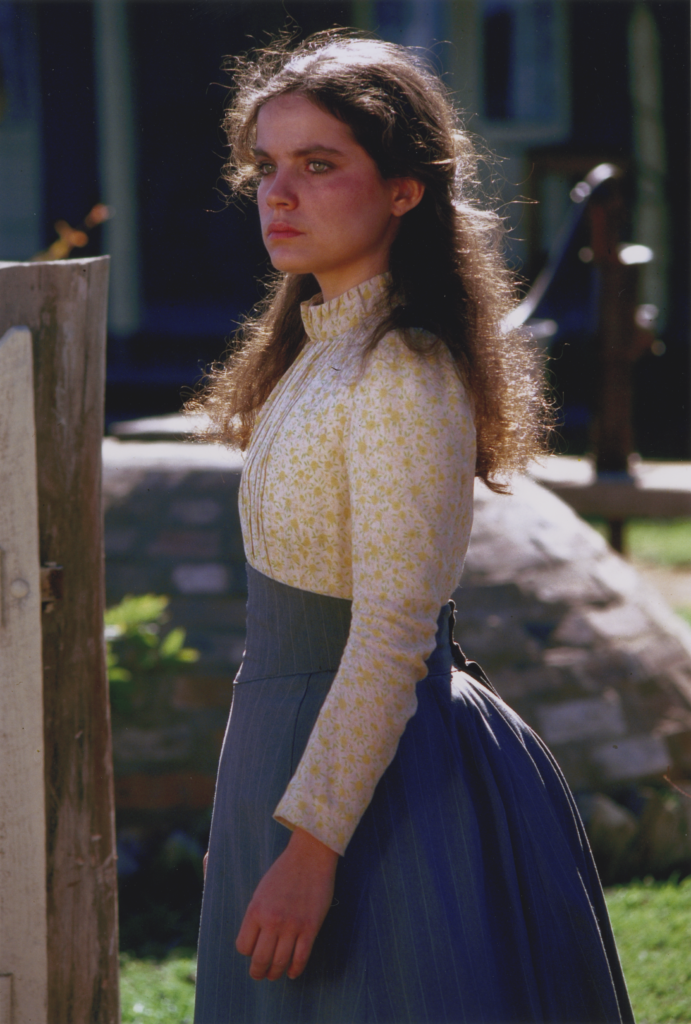
Jim then returns to the mountains, where presumably, having become the ‘man’ of the film’s title, he is able to reclaim his family property and live with his horses and his woman (a situation explored in the 1988 sequel, directed by Burrowes). In this climax, Jim is literally bestowed with the title role of the film: ‘He’s not a lad, he’s a man,’ says one character on Jim’s return with the horses. ‘The man from Snowy River,’ adds another. Here, the geographic fantasy of terra nullius combines with patriarchal authority to tell a coming-of-age story in which landscape, livestock and women are all rendered alike as property symbols, used to indicate the status of white men.
Of course, wild horses are feral animals in Australia, and the fact that the film continually portrays them as inherently ‘wild’ and linked with the landscape itself reinforces its fabricated view of Australia and its settler culture. The horses are no more a natural part of the environment than The Man from Snowy River’s white settlers, yet the film treats both as unexceptional in this world. This might also explain the strange lack of native wildlife in this otherwise-reified view of Australiana: though wallabies, for example, are frequently mentioned, none are actually present in any scenes. Perhaps their appearance would have reminded audiences how alien horses and cattle actually are in this environment, and that this coming-of-age story is conducted entirely on colonial terms.
Indeed, any acknowledgement that this land was, in fact, occupied well before European settlement would have complicated the postcard-perfect view of Australia that the film has taken as its iconography. The appeal of the film is strongly couched in an uncomplicated view of Australia and its history. A coming-of-age plot does not work if the hero has transgressed before it begins, and stolen land cannot be reclaimed by thieves quite so chivalrously. Instead, Burrowes and Miller wanted to create a fictional universe that would allow a settler story to be told on the settler’s terms without reality intruding. In this respect the film’s monolithic racial story is at least in part a product of their desire to create a work of escapist entertainment. For Miller,
Snowy is a love letter to Australia and, for Geoff, a love letter to the mountains. We can’t understand why any filmmaker would want to depress an audience. If you want to get depressed, turn on the television and watch the news.[31]Miller, quoted in Tosi, op. cit., p. 211.
In this respect, again, Burrowes and Miller are similar to the Americans Lucas and Spielberg, who had transformed their industry by returning to the escapist, fairytale fare that had dominated the entertainment industries in earlier decades of the twentieth century. This is not to agree that escapist entertainment must erase Australian history to be enjoyable (in fact, more recent films like Rachel Perkins’ 2009 Bran Nue Dae have proved just the opposite), but rather that Burrowes and Miller saw it that way and acted accordingly. Indeed, this seems to be Miller’s continuing attitude to filmmaking: in a 2008 profile, he claimed that contemporary Australian cinema was too glum: ‘Aboriginals, whales, a lesbian and an unhappy ending – boy let’s make this film,’ he scoffed.[32]Miller, quoted in Schmidt, op. cit.
Nonetheless, it’s clear that the emphasis in The Man from Snowy River was on creating an aesthetically pleasing sense of the Australian landscape. Whatever the underlying framework for this strategy, it successfully connected with its audience. Indeed, so perfect was the representation of the Australian bush that an entire cottage industry of horseback and adventure tours sprung up around the Mansfield district in Victoria where the film was shot. Horseback tourism in the mountainous highlands increased from three operators before the release of The Man from Snowy River to more than thirty in 1996. Between 1981 and 1988 alone, tourism from the United States to Australia increased by more than 20.5 per cent per annum, something that tourism researcher Sue Beeton attributes, to some degree, to the impact of films like The Man from Snowy River.[33]Sue Beeton, Film-induced Tourism, Channel View Publications, Clevedon, 2005, p. 23.
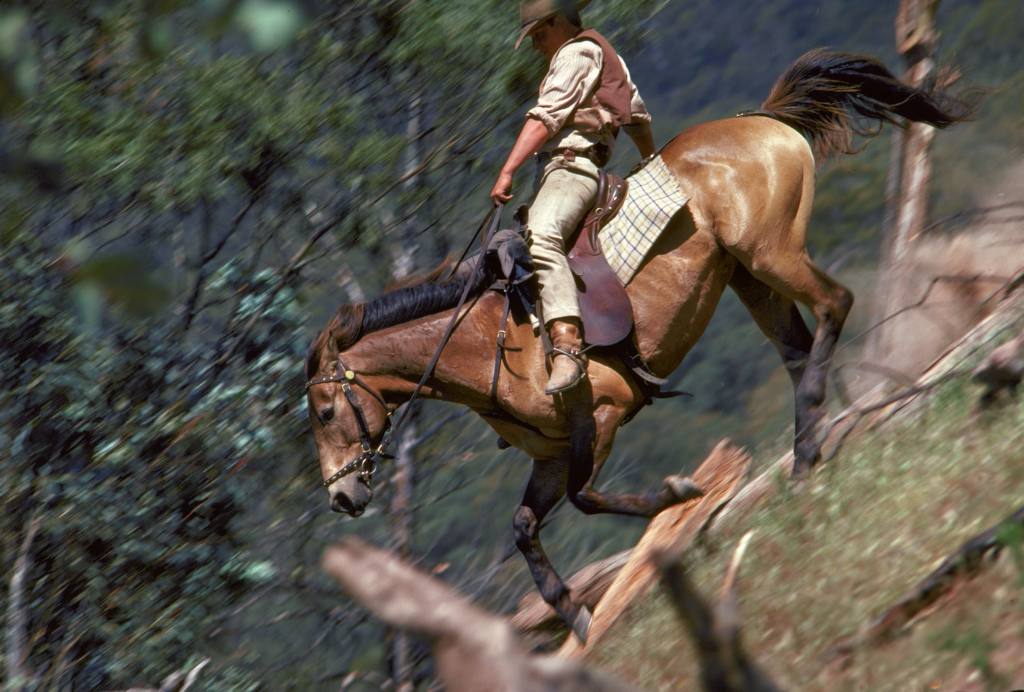
Nation-building and The Man
If The Man from Snowy River had an actual impact on the nation’s economy, it was not particularly accidental. Burrowes and Miller specifically set out to make the film at least partly as a nation-building exercise. ‘We’re dealing with a legend,’ Burrowes, who had been press secretary to Whitlam government minister Moss Cass, told The Australian Women’s Weekly while the film was being shot. ‘It has to be excellent.’[34]Geoff Burrowes, quoted in Turner, op. cit., p. 15. Beyond the initial conception of the film as something that addressed Australia’s heritage front-on, both Burrowes and Miller spoke of to some extent doubling Jim with the Australian national character. ‘When Jim wins, Australia wins,’ said Burrowes, who also fondly recalls audience members cheering, and telling him that the film made them proud to be Australian.[35]Burrowes, quoted in Tosi, op. cit., pp. 211–2. O’Regan also smartly links the popularity of the film with the ascendency, in the 1980s, of a particular type of rural culture: the emergence of country-and-western radio stations in outback Australia, riding schools, the popularity of clothing brand R.M.Williams, growth in the rodeo circuit, and the overall resurgence of such imagery in adverts for beer, cigarettes and popular entertainment.[36]O’Regan, op. cit., p. 8.
Of course, this is in no small part related to the subject matter, and Paterson’s poem. Published in 1890, ‘The Man from Snowy River’ arrived at a time when Australian nationalism was building. National conventions were held throughout the decade to discuss and call for Federation, which was eventually enacted in 1901. The Australian national character, its underlying principles and its myths were all very much topics of conversation and debate. Paterson’s poem was first published in The Bulletin, a magazine known for its nationalist, pro-republic and pro-labour agitation, as well as for its stable of bush poets, including Paterson, Henry Lawson (who famously attacked Paterson for being a ‘City Bushman’ who romanticised country life from the safety of the city[37]Kathryn Wells et al., ‘The Australian Bush’, Australia.gov.au, 1 March 2011, <http://www.australia.gov.au/about-australia/australian-story/austn-bush>, accessed 21 August 2017.) and Harry ‘Breaker’ Morant.
The image of the bush as somehow playing into national identity – or, better still, as intangibly defining it – was distilled during this period. Even today, with our largely urban population and high percentage of first- and second-generation migrants, the ideas of the bush and the bushman are still central to our national identity. Poems such as ‘The Man from Snowy River’ and ‘Clancy of the Overflow’ have been promoted as ‘national symbols of the bushman’ that are now ‘enshrined in our cultural mythology’.[38]Clement Semmler, ‘Introduction’, in David Parker, A Tribute to The Man from Snowy River, Sydney, Angus & Robertson, 1982, p. 7. Paterson, and the film’s titular poem, are today featured on the Australian ten-dollar note, on which the full text of the poem is printed several times in microprint.
Certainly, when Burrowes and Miller made their film – almost one hundred years later, in 1982 – they were not reviving some forgotten relic of proto-Australiana. In fact, the poem had already been adapted in 1920 by Beaumont Smith and John K Wells. Interestingly, Smith also reworks the poem as a coming-of-age story, using the bush (and the horse chase within it) as a setting for the rakish city-boy Jim Conroy (another Jim as the ‘man’) to rediscover himself and find love. Nor would Burrowes and Miller be the last to adapt the poem after the Burrowes-directed sequel. From 1993 to 1996, there was a four-season television series for the Nine Network that had no relationship to either the film or its sequel – in fact, Burrowes sued the producers of the television series for using the title. Though taking the same setting as the poem, the series – which starred Andrew Clarke and Wendy Hughes, with early-career roles for eventual stars Guy Pearce and Hugh Jackman – was more of a family drama. The influence of the poem continues to expand: in 2002, there was a musical-theatre production (The Man from Snowy River: Arena Spectacular) starring Georgie Parker, Charles ‘Bud’ Tingwell, Lee Kernaghan, and Steve Bisley as Paterson himself. And, every year since 1995, The Man from Snowy River Bush Festival has been held in Corryong, northern Victoria; sponsored by R.M.Williams, the event includes bush poetry, music, a rodeo, a ute muster and historic machinery.
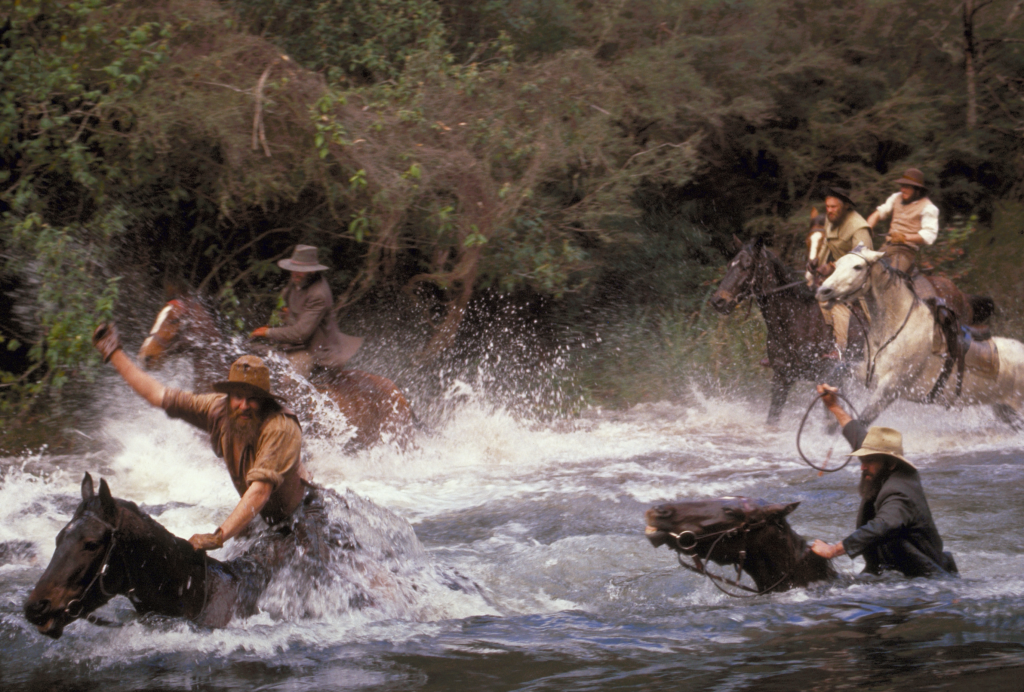
Yet there is also significance to why The Man from Snowy River should have been adapted in 1982, and for why it should have connected so clearly with the Australian filmgoing audience of the time. Just as the original poem was published in the years leading up to federation, the film was released only six years before one of the more significant Australian cultural events of the time: the bicentenary of 1988, which marked 200 years since the arrival of the First Fleet. To commemorate this occasion, Australia held a yearlong program of activities, including a re-enactment of the arrival of the fleet on Australia Day, television specials and sporting events, all of which had been devised and planned by a federal body (the Australian Bicentennial Authority) since 1980. In Canberra on Australia Day, horses and riders completing the ‘Man from Snowy River Rides Again’ trek paraded through the city’s streets.[39]David Carment, ‘Unfurling the Flag: Historians, Identity and Politics in Australia and the Northern Territory’, Journal of Northern Territory History, no. 16, 2005, p. 31. The authority further encouraged Australians to celebrate in a variety of ways:
Plant shrubs, hedges and trees… make community litter bags… Re-enact an episode from your district’s past… Make a census of the headstones… Organize an Australiana Trivial Pursuit Game… Bake an Australia-shaped cake for a raffle.[40]Cited in Stephen Castles et al., The Bicentenary and the Failure of Australian Nationalism, Centre for Multicultural Studies, University of Wollongong, occasional paper no. 5, November 1987, p. 3.
The bicentenary was, of course, not uncontroversial; in fact, it was widely protested and boycotted, especially by Aboriginal rights groups. Yet 1988 as a cultural and historical moment had been broadly prepared for since the early 1980s by a series of films that examined, in a popular framework, Australia’s national myths and identity – but never so deeply as to destabilise them. The Man from Snowy River certainly fits here, as do Gallipoli and Breaker Morant, both of which depict less glossy visions of Australian history but nonetheless engage very clearly with Australian identity as something worth enriching. Interestingly, however, a further strain of these kinds of films emerged from various personnel directly involved in The Man from Snowy River, including Wincer (Phar Lap, also starring Burlinson; The Lighthorsemen, 1987, also starring Thornton; and The Last Frontier,1986, a telemovie also starring Thompson) and Miller (Bushfire Moon, 1987; and All the Rivers Run, a 1983 miniseries also starring Thornton). Perhaps the most notable future collaboration in this vein was the five-part 1985 miniseries Anzacs, which was produced by Burrowes and co-directed by Miller. This series, which depicted a group of Australian troops at war, carefully constructed a glamorised version of the Anzac myth at great expense. Burrowes later claimed Anzacs was possible only because of the financial success of The Man from Snowy River. In any case, according to researcher Daniel Reynaud, it ‘seemed to owe something to both The Man from Snowy River and soap opera’, perhaps continuing to indicate Burrowes and Miller’s roots at Crawford.[41]Daniel Reynaud, Celluloid Anzacs: The Great War Through Australian Cinema, Australian Scholarly Publishing, Melbourne, 2007, p. 206.
In this context, it seems no coincidence that The Man from Snowy River should be successfully adapted at the start of the 1980s, almost as a prelude of all of this to come. As Stephen Alomes has argued, this decade saw a general rise in a nationalistic consciousness in Australia, something that was reflected not just in film and television, but also in music (with the success of bands like INXS and Men at Work), art (Ken Done), sport (the America’s Cup and the Davis Cup) and, perhaps most importantly, the distinctively Australian political rhetoric of former prime minister Bob Hawke, whose government funded much of this activity. Accordingly, a film like The Man from Snowy River was designed ‘to encourage Australians’ pride in traditions of their national past’.[42]Stephen Alomes, A Nation at Last?: The Changing Character of Australian Nationalism 1880–1988, Angus & Robertson, Sydney, 1988, p. 206.
That it has done – insofar as the film has become a kind of tradition in itself, and a handy symbol of Australian tourism and national identity. At the 2000 Olympic Games in Sydney, the opening ceremony began with a lone horseman – The Man from Snowy River, we were told in voiceover – galloping to the centre of the arena, before being joined by 120 riders carrying Olympic flags. This was all performed to the sound of Rowland’s main theme for the 1982 film, arranged specially for the occasion (the sequence concluded with a giant Ken Done–painted banner that read ‘G’Day’ being dropped from the ceiling). In 2008, then–Victorian Liberal Party leader Ted Baillieu used the reconstruction of Craig’s hut, a set from the film that had become a tourist attraction in its own right, to remind the nation, ‘The Snowy films in the early 1980s awakened pride in Australia’s bush heritage’.[43]Ted Baillieu, quoted in Jason Dowling, ‘Like the Colt of Old Regret, a Minister Bolts’, The Age, 27 January 2008, <http://www.theage.com.au/news/national/like-the-colt-of-old-regret-a-minister-bolts/2008/01/26/1201157739209.html>, accessed 21 August 2017.
The Man from Snowy River has a mixed and complicated legacy, and in many ways remains at the heart of the push-and-pull around populist Australian culture. Paul Byrnes’ official curator’s notes for the film’s entry in the National Film and Sound Archive of Australia sums much of this up: ‘It’s a naive film of epic proportions, but the naiveté is calculated to appeal to a sense of American nostalgia, and Australian chauvinism.’[44]Paul Byrnes, ‘Curator’s Notes’, ‘The Man from Snowy River (1982)’, australianscreen, <https://aso.gov.au/titles/features/man-snowy-river/notes/>, accessed 21 August 2017. Though it’s a long way from the simplistic, poorly made film that critics pummelled in 1982, The Man from Snowy River nonetheless is a vehicle for certain kinds of fantasy – both positive and negative – about the Australian nation.
This article has been refereed.
https://clickv.ie/w/metro/the-man-from-snowy-river
Select bibliography
Stephen Alomes, A Nation at Last?: The Changing Character of Australian Nationalism 1880–1988, Angus & Robertson, Sydney, 1988.
Stephen Castles et al., The Bicentenary and the Failure of Australian Nationalism, Centre for Multicultural Studies, University of Wollongong, occasional paper no. 5, November 1987.
Jack Clancy, ‘Second Glance: The Man from Snowy River, Parents and Orphans’, Cinema Papers, issue 42, March 1983, pp. 50–2.
Denise Hare, ‘Man from Snowy River’, Filmnews, April 1982, p. 13.
Rose Lucas, ‘Dragging It Out: Tales of Masculinity in Australian Cinema, from Crocodile Dundee to Priscilla, Queen of the Desert’, Journal of Australian Studies, vol. 22, no. 56, 1998, pp. 138–46.
Tom O’Regan, ‘Ride the High Country: The Man From Snowy River & Australian Popular Culture’, Filmnews, September 1982, pp. 8–9.
Daniel Reynaud, Celluloid Anzacs: The Great War Through Australian Cinema, Australian Scholarly Publishing, Melbourne, 2007.
Lucinda Schmidt, ‘Profile: George Miller’, The Sydney Morning Herald, 6 February 2008, <http://www.smh.com.au/news/money/profile
-george-miller/2008/02/04/1202090322001.html>, accessed 21 August 2017.
George Tosi, ‘Geoff Burrowes and George Miller: Two Men Behind Snowy River,’ Cinema Papers, issue 38, June 1982, pp. 207–12, 283.
Arnold Zable, ‘The Man from Snowy River’, Cinema Papers, issue 38, June 1982, pp. 261–2.
MAIN CAST
Jim Craig Tom Burlinson Jessica Harrison Sigrid Thornton Harrison / Spur Kirk Douglas Clancy Jack Thompson Henry Craig Terence Donovan Banjo Paterson David Bradshaw Curly Chris Haywood Frew Gus Mercurio Mrs Bailey June Jago
PRINCIPAL CREDITS
Year of release 1982 Length 102 minutes Director George Miller Producer Geoff Burrowes Executive Producers Michael Edgley, Simon Wincer Screenplay John Dixon, Fred Cul Cullen Cinematography Keith Wagstaff Sound Terry Rodman Music Bruce Rowland Costumes Robin Hall Editing Adrian Carr Art Direction Leslie Binns Based on a poem by AB ‘Banjo’ Paterson
Endnotes
| 1 | Tom O’Regan, ‘Ride the High Country: The Man from Snowy River & Australian Popular Culture’, Filmnews, September 1982, p. 8. |
|---|---|
| 2 | Geoff Burrowes, quoted in George Tosi, ‘Geoff Burrowes and George Miller: Two Men Behind Snowy River,’ Cinema Papers, issue 38, June 1982, p. 207. |
| 3 | Jock Given, ‘Did the Networks Kill Homicide?’, Inside Story, 2 July 2014, <http://insidestory.org.au/did-the-networks-kill-homicide>, accessed 21 August 2017. |
| 4 | George Miller, quoted in Lucinda Schmidt, ‘Profile: George Miller’, The Sydney Morning Herald, 6 February 2008, <http://www.smh.com.au/news/money/profile-george-miller/2008/02/04/1202090322001.html>, accessed 21 August 2017. |
| 5 | O’Regan, op. cit., p. 8. |
| 6 | Alex Burns & Ben Eltham, ‘Boom and Bust in Australian Screen Policy: 10BA, the Film Finance Corporation and Hollywood‘s “Race to the Bottom”’, Media International Australia, Incorporating Culture & Policy, no. 136, 2010, pp. 105–6. |
| 7 | O’Regan, op. cit., p. 8. |
| 8 | George Miller, quoted in Tosi, op. cit., p. 208. |
| 9 | Jack Clancy, ‘Second Glance: The Man from Snowy River, Parents and Orphans’, Cinema Papers, issue 42, March 1983, p. 52. |
| 10 | Burrowes, quoted in Tosi, op. cit., p. 209. |
| 11 | ibid., p. 210. |
| 12 | ibid. |
| 13 | Dougal McDonald, ‘Kirk Douglas Is Snowy Man’, The Canberra Times, 3 March 1981, p. 13. |
| 14 | Burrowes, quoted in Tosi, op. cit., p. 210. |
| 15 | ibid. |
| 16 | Screen Australia, ‘Top 100 Australian Feature Films of All Time’, 16 May 2017, <https://www.screenaustralia.gov.au/fact-finders/cinema/australian-films/top-films-at-the-box-office>, accessed 21 August 2017. |
| 17 | Bob Thomas, ‘Man from Snowy River – “A Remarkable Movie”’, The Canberra Times, 26 January 1983, p. 20. |
| 18 | Screen Australia, ‘All-time Top-rating Australian Feature Films on Television, 1980–2009’, <https://www.screenaustralia.gov.au/fact-finders/television/australian-content/in-the-archive/top-movies-of-all-time>, accessed 21 August 2017. |
| 19 | Geoff Burrowes, ‘“Snowy River’s” Got $18.5 Million to Say Cinema Papers Is Wrong’, advertisement, Cinema Papers, issue 43, May–June 1983, p. 156. |
| 20 | Sandy George & Bernadette Rheinberger, ‘94 Films: A Commercial Analysis’, Screen Australia website, 11 April 2017, <https://www.screenaustralia.gov.au/sa/screen-news/2017/02-28-94-films-a-commercial-analysis/part-3-best-financial-performers>, accessed 21 August 2017. |
| 21 | Denise Hare, ‘Man from Snowy River’, Filmnews, April 1982, p. 13. |
| 22 | Both cited in Arnold Zable, ‘The Man from Snowy River’, Cinema Papers, issue 38, June 1982, pp. 261. |
| 23 | ibid., pp. 261–2. |
| 24 | Burrowes, quoted in Tosi, op. cit., p. 283. |
| 25 | Miller, quoted in Tosi, ibid., p. 209. |
| 26 | ibid., p. 283. |
| 27 | Bunty Turner, ‘A Bush Legend Comes to Life’, The Australian Women’s Weekly, 6 May 1981, p. 14. |
| 28 | Miller, quoted in Tosi, op. cit., p. 211. |
| 29 | O’Regan, op. cit., p. 9. |
| 30 | Rose Lucas, ‘Dragging It Out: Tales of Masculinity in Australian Cinema, from Crocodile Dundee to Priscilla, Queen of the Desert’, Journal of Australian Studies, vol. 22, no. 56, 1998, p. 140. |
| 31 | Miller, quoted in Tosi, op. cit., p. 211. |
| 32 | Miller, quoted in Schmidt, op. cit. |
| 33 | Sue Beeton, Film-induced Tourism, Channel View Publications, Clevedon, 2005, p. 23. |
| 34 | Geoff Burrowes, quoted in Turner, op. cit., p. 15. |
| 35 | Burrowes, quoted in Tosi, op. cit., pp. 211–2. |
| 36 | O’Regan, op. cit., p. 8. |
| 37 | Kathryn Wells et al., ‘The Australian Bush’, Australia.gov.au, 1 March 2011, <http://www.australia.gov.au/about-australia/australian-story/austn-bush>, accessed 21 August 2017. |
| 38 | Clement Semmler, ‘Introduction’, in David Parker, A Tribute to The Man from Snowy River, Sydney, Angus & Robertson, 1982, p. 7. |
| 39 | David Carment, ‘Unfurling the Flag: Historians, Identity and Politics in Australia and the Northern Territory’, Journal of Northern Territory History, no. 16, 2005, p. 31. |
| 40 | Cited in Stephen Castles et al., The Bicentenary and the Failure of Australian Nationalism, Centre for Multicultural Studies, University of Wollongong, occasional paper no. 5, November 1987, p. 3. |
| 41 | Daniel Reynaud, Celluloid Anzacs: The Great War Through Australian Cinema, Australian Scholarly Publishing, Melbourne, 2007, p. 206. |
| 42 | Stephen Alomes, A Nation at Last?: The Changing Character of Australian Nationalism 1880–1988, Angus & Robertson, Sydney, 1988, p. 206. |
| 43 | Ted Baillieu, quoted in Jason Dowling, ‘Like the Colt of Old Regret, a Minister Bolts’, The Age, 27 January 2008, <http://www.theage.com.au/news/national/like-the-colt-of-old-regret-a-minister-bolts/2008/01/26/1201157739209.html>, accessed 21 August 2017. |
| 44 | Paul Byrnes, ‘Curator’s Notes’, ‘The Man from Snowy River (1982)’, australianscreen, <https://aso.gov.au/titles/features/man-snowy-river/notes/>, accessed 21 August 2017. |
